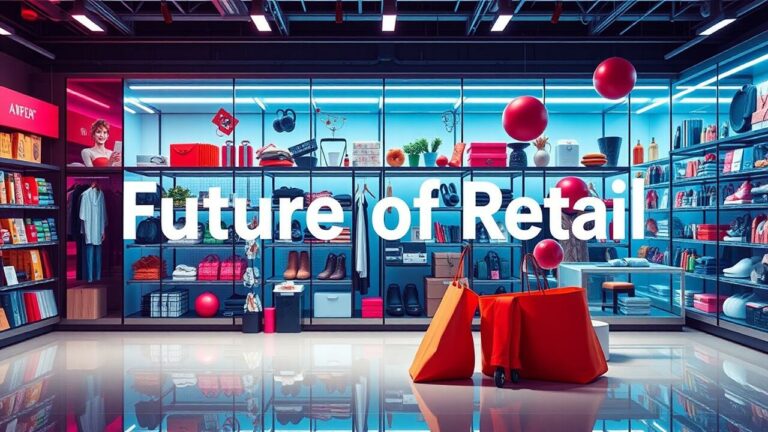Retail Tech Trends
The Shift Towards Omnichannel Retailing
Retailers are increasingly awakening to the undeniable truth: a seamless shopping experience across a myriad of channels is no longer just a luxury—it’s an expectation. In this dynamic landscape, customers crave interaction with brands through all sorts of touchpoints—be it in-store, online, or via mobile apps. This monumental shift compels businesses to weave their operations into a cohesive tapestry, ensuring that product availability, pricing consistency, and customer service resonate harmoniously across every platform.
Enter advanced technologies! Data analytics and customer relationship management systems emerge as pivotal players in this intricate dance, unlocking insights into customer behaviors and preferences that were once elusive.
Embracing an omnichannel strategy doesn’t merely elevate customer satisfaction; it ignites sales growth like never before. By orchestrating a unified brand experience, retailers can spark deeper engagement and cultivate unwavering brand loyalty among their patrons. Plus—and here’s where it gets interesting—the capacity to collect and dissect customer data from various sources empowers businesses to hone their marketing efforts with laser-like precision.
In this ever-evolving arena of retailing complexities, mastering the art of omnichannel strategies has transformed into not just advantageous but essential for those daring enough to thrive amidst fierce competition.
Creating Seamless Customer Journeys Across Platforms
The merging of online and offline shopping experiences has become absolutely vital, as businesses scramble to keep up with the ever-shifting landscape of consumer demands. Nowadays, shoppers flit between a plethora of channels—websites, mobile apps, brick-and-mortar stores—each time expecting a seamless experience that feels uniform no matter where they choose to engage. Retailers who manage to weave consistent branding and messaging throughout every interaction not only bolster brand loyalty but also ensure that customers have positive encounters with their offerings. This omnichannel strategy opens the floodgates for retailers to amass rich data insights; they can sculpt personalized experiences rooted in unique preferences and behaviors.
Yet, the magic trick behind this fluid transition between channels? Technology is at its heart! Cutting-edge systems for inventory management, customer relationship management (CRM), and analytics are paramount in crafting an uninterrupted shopping journey. Consider tools offering real-time inventory updates—they empower consumers to make savvy purchasing choices whether they’re lounging on their couch or wandering through aisles in-store. And let’s not overlook how integrating customer service solutions across various platforms streamlines issue resolution like a well-oiled machine—boosting overall satisfaction levels sky-high! By honing in on these crucial elements, retailers can cultivate an ecosystem where each customer feels genuinely valued and understood amidst this chaotic retail landscape.
Social Commerce
The fusion of shopping and social media has revolutionized how consumers engage with brands in ways that are both exciting and dynamic. Platforms like Instagram and Facebook have jumped on this trend, weaving shopping features seamlessly into their fabric—allowing users to snatch up products they stumble upon mid-scroll. The inherently visual appeal of these platforms doesn’t just showcase products; it sparks desire, nudging many towards those impulsive buys we all know too well. Retailers are riding this wave by crafting shoppable posts and stories, creating an effortless flow from casual browsing to actual purchasing.
And then there are influencers—the catalysts of sales in this vibrant ecosystem! Their knack for forging genuine connections with audiences fosters a level of trust that translates directly into higher conversion rates for the brands they champion. When businesses team up with the right influencers, it’s like hitting the jackpot—they tap into specific demographics while leveraging the influencer’s credibility to amplify brand visibility and drive sales. This relationship is a win-win: influencers gain fresh content opportunities while retailers bask in increased customer engagement and revenue streams. It’s a dance between authenticity and commerce that keeps evolving at breakneck speed!
Leveraging Influencers to Boost Sales
Influencer marketing has utterly reshaped the retail landscape, injecting a fresh dose of authenticity into brand narratives that truly resonate with target audiences. By collaborating with these digital trailblazers, companies can tap into wells of established trust and credibility—resulting in engagement rates soaring to new heights and conversions dancing upwards. Customers often view these online ambassadors as relatable figures, making their endorsements far more potent than the tired tropes of traditional advertising.
But wait, there’s more! The artful selection of influencers whose values harmonize with the essence of a brand allows retailers to not just amplify their reach but also cultivate genuine connections with potential buyers—connections that pulse with real human emotion.
Imagine this: influencers showcasing products nestled within everyday scenarios—their lives intertwining seamlessly with what they promote, crafting an allure that’s hard to resist for followers hungry for authenticity. Furthermore, savvy data tracking offers a treasure trove of insights about campaign performance; brands can refine strategies adroitly, ensuring maximum impact in every effort.
In short? By wielding the influence of key opinion leaders deftly and strategically, retailers have the power to morph casual viewers into steadfast customers—all while noticeably escalating sales and enhancing brand visibility amid a fiercely competitive market landscape.
| Influencer Type | Engagement Rate | Typical Campaign Reach | Best Industry Fit |
|---|---|---|---|
| Micro-Influencers | 5-10% | 10,000 – 100,000 followers | Fashion, Beauty, Food |
| Macro-Influencers | 2-5% | 100,000 – 1 million followers | Lifestyle, Fitness, Travel |
| Celebrities | 1-3% | 1 million + followers | Entertainment, Sports, Luxury |
| Industry Experts | 3-7% | 50,000 – 300,000 followers | Tech, Health, Finance |
The Evolution of E-commerce Platforms
Oh, how the realm of online shopping has morphed and twisted in remarkable ways over the last few years! Retailers now wield cutting-edge e-commerce platforms—crafted with an eye toward elevating user experience into something almost magical. Imagine systems that weave together AI-driven analytics, offering businesses a kaleidoscope of insights into consumer behavior and whims. Responsive design? Absolutely essential! Websites now dance seamlessly across all devices, creating a fluidity that not only delights customers but also propels conversion rates to new heights.
And let’s not overlook the tidal wave of personalization washing over e-commerce—it’s rewriting the script on how brands forge connections with their audience. With machine learning algorithms as their secret weapons, these platforms conjure up bespoke shopping adventures tailored to each individual’s unique browsing escapades and purchasing tales. Subscription services and loyalty programs are weaving themselves ever more intricately into the fabric of online commerce, nurturing enduring relationships with customers like precious vines creeping along a trellis. These dynamic features aren’t just bells and whistles; they’re pivotal in driving user engagement, positioning retailers to thrive amidst an increasingly frenetic marketplace where competition is fierce and relentless!
Features Driving User Engagement and Retention
In the ever-evolving realm of e-commerce, user engagement and retention have risen to prominence as indispensable metrics for platforms eager to forge enduring connections with their customers. Ah, but here’s where personalization takes center stage! This dazzling feature empowers platforms to craft content, product recommendations, and marketing messages that resonate on an individual level—like a tailor fitting a bespoke suit. Advanced algorithms delve into the labyrinth of user behavior, transforming shopping into an experience rich with relevance and satisfaction.
But wait—there’s more! Enter gamification elements: rewards systems that sparkle like gold coins in a treasure chest and interactive features that beckon users to dive deeper into the brand’s offerings. These tools don’t just engage; they enchant users, urging them to explore products with child-like curiosity.
Now let’s talk about mobile optimization—a non-negotiable in today’s fast-paced market! As consumers increasingly clutch their smartphones like lifelines for shopping escapades, e-commerce platforms must elevate mobile experiences to new heights. Picture it: pages loading at lightning speed, navigation so intuitive it feels instinctual, and one-click purchasing whisking you away from cart abandonment woes—all designed to make buying feel effortless!
And what about customer service? Enter live chat support—a beacon of instant assistance illuminating the path through any uncertainty shoppers may face. With questions answered in real-time, confidence blooms like spring flowers in making purchases. Together these features create not just a vibrant ecosystem but a magnetic environment that draws users back time after time—it’s an alluring dance between brands and buyers!
Robotics and Automation in Warehousing
The fusion of robotics and automation in the realm of warehousing is nothing short of a seismic shift in the logistics landscape. Picture this: automated systems weaving effortlessly through a tapestry of operations, from meticulously managing inventory to seamlessly fulfilling orders. Robots, those tireless sentinels, now execute repetitive tasks with an astonishing blend of precision and speed that seems almost otherworldly. What’s more? These innovations usher in a new era marked by slashed labor costs, diminished human errors, and a remarkable surge in productivity. Consequently, warehouses are not merely keeping pace; they’re handling staggering volumes of goods while preserving workflows that hum with efficiency.
But wait—there’s more! The embrace of cutting-edge technology paves the way for unprecedented space utilization within these vast storage realms. Automated guided vehicles glide gracefully through aisles as if dancing to an invisible rhythm, all while requiring minimal human oversight. This dynamic duo not only accelerates the picking process but also redefines storage strategies like never before. Businesses find themselves awash in real-time data analytics that illuminate inventory levels and operational performance with clarity akin to daylight breaking through clouds. With such illuminating insights at their fingertips, decision-making transforms into an art form—one where strategies can pivot deftly to navigate the unpredictable tides of demand fluctuations.
Increasing Efficiency with Automated Solutions
The fusion of robotics and automation within the realm of retail warehousing has sparked a remarkable metamorphosis in operational dynamics. Picture this: automated systems deftly orchestrating inventory management, where robotic arms whir and whirl to sort and shelve products with precision. The result? A dramatic reduction in the time it takes to fulfill orders, coupled with a significant drop in human error—ushering in an era of heightened accuracy for those ever-important inventory counts.
But wait, there’s more! Advanced algorithms—the brainiacs of efficiency—step into the spotlight, optimizing storage layouts while predicting when stock needs replenishing based on real-time sales data. It’s like having a crystal ball that whispers secrets about what’s flying off the shelves!
Moreover, this wave of automation doesn’t just replace hands; it redefines roles. With machines tackling routine and repetitive tasks, human resources can pivot towards endeavors demanding creativity and nuanced skills. Employees are liberated from drudgery, channeling their energies instead into enhancing customer experiences and sparking sales growth—a delightful win-win!
This evolution not only cultivates innovation among workers but also nudges them toward acquiring new skill sets that resonate with our rapidly changing technological landscape. All told, embracing these automated solutions crafts a retail environment that’s not just productive but also astonishingly agile—ready to dance through challenges like never before!
Enhancing Cybersecurity in Retail
The growing dependence on digital platforms has turned the retail sector into a veritable playground for cybercriminals. In this landscape, retailers must not just dip their toes but dive headfirst into robust cybersecurity measures to shield sensitive customer information and uphold trust like a fragile glass ornament. Enter multi-factor authentication—a knight in shining armor that fortifies security by demanding extra verification from users, elevating protection levels significantly.
But wait! The saga doesn’t end there; regular software updates are absolutely essential. Think of them as patches for vulnerabilities—tiny openings that malicious actors might exploit like unwelcome guests slipping through the cracks. And let’s not forget routine security audits—they’re akin to having a vigilant watchtower, identifying weaknesses and shoring up defenses across retail operations.
Now, let’s talk about education and training for employees—these aren’t mere add-ons; they’re crucial lifelines in the fight against cyber threats. Staff need to be equipped with skills to spot phishing attempts from miles away while grasping the critical importance of password management like it’s second nature. Clear protocols for data handling? Absolutely necessary—to counteract human error lurking around every corner.
Retailers should also look toward investing in cutting-edge technology like artificial intelligence—a formidable ally that can detect and react to threats in real time, almost as if it possesses foresight! By nurturing a culture steeped in security awareness, retail businesses can lock down their assets tighter than Fort Knox while crafting an environment where customers feel safe shopping without a worry on their minds.
Protecting Customer Data in a Digital Landscape
In a world swirling with the chaos of data breaches and lurking cyber threats, retailers find themselves at a crossroads where the safeguarding of customer information takes center stage. It’s not just important; it’s essential to forge an impenetrable fortress around sensitive data. Imagine encryption technologies weaving a protective cloak over transactions, while multifactor authentication stands guard like an ever-watchful sentinel during those crucial login moments. Regular security audits? They’re not merely routine—they’re vital inspections that unveil vulnerabilities, allowing businesses to tackle them before they spiral into disasters.
But wait! The plot thickens—employees are pivotal players in this intricate drama of data protection. By equipping staff with knowledge about best practices for handling information and navigating cybersecurity protocols, companies can dramatically reduce risks that lurk in the shadows. And let’s not overlook the necessity of cultivating a culture steeped in security awareness; when every member of the organization becomes vigilant against potential cyber adversaries, they transform into an unyielding line of defense. Thus, by fusing cutting-edge technology with comprehensive employee training, retail enterprises can construct a resilient framework designed to shield customer data amidst today’s tumultuous digital landscape—a true bastion against impending threats!
- Implement robust encryption methods for data protection during transactions.
- Utilize multifactor authentication for enhanced user security.
- Conduct regular security audits to identify and address vulnerabilities.
- Provide ongoing training for employees on cybersecurity best practices.
- Foster a culture of security awareness across the organization.
- Establish clear protocols for incident response and data breach management.
- Collaborate with cybersecurity experts to stay updated on emerging threats.
Conclusion
The retail scene is in a whirlwind of transformation, propelled by the relentless march of technology and the shifting tides of consumer habits. Brands that dare to embrace omnichannel strategies are weaving together shopping experiences that not only elevate customer satisfaction but also cultivate unshakeable loyalty. The surge in social commerce and the meteoric rise of influencer marketing starkly illustrate just how vital it is for retailers to rethink their game plans if they want to stay ahead in this cutthroat arena.
As we gaze into the future, businesses must pivot towards harnessing cutting-edge e-commerce platforms while weaving automation into their daily operations like a master craftsman. But wait—amidst all this digital hustle and bustle, securing robust cybersecurity measures becomes paramount; after all, protecting customer data isn’t just smart—it’s essential for preserving trust in an ever-evolving digital landscape. As the industry hurtles forward, those retailers who adeptly ride these waves of change will find themselves not merely surviving but thriving within an increasingly intricate marketplace.







